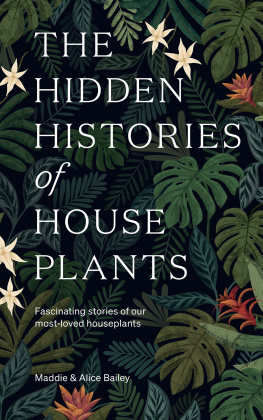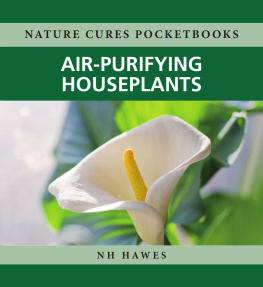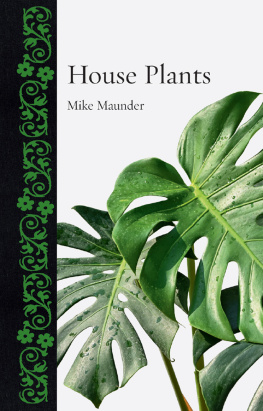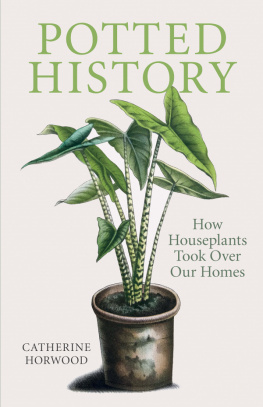Maddie Bailey - The Hidden Histories of House Plants: Fascinating Stories of Our Most-Loved Houseplants
Here you can read online Maddie Bailey - The Hidden Histories of House Plants: Fascinating Stories of Our Most-Loved Houseplants full text of the book (entire story) in english for free. Download pdf and epub, get meaning, cover and reviews about this ebook. year: 2020, publisher: Hardie Grant Publishing, genre: Religion. Description of the work, (preface) as well as reviews are available. Best literature library LitArk.com created for fans of good reading and offers a wide selection of genres:
Romance novel
Science fiction
Adventure
Detective
Science
History
Home and family
Prose
Art
Politics
Computer
Non-fiction
Religion
Business
Children
Humor
Choose a favorite category and find really read worthwhile books. Enjoy immersion in the world of imagination, feel the emotions of the characters or learn something new for yourself, make an fascinating discovery.
- Book:The Hidden Histories of House Plants: Fascinating Stories of Our Most-Loved Houseplants
- Author:
- Publisher:Hardie Grant Publishing
- Genre:
- Year:2020
- Rating:4 / 5
- Favourites:Add to favourites
- Your mark:
- 80
- 1
- 2
- 3
- 4
- 5
The Hidden Histories of House Plants: Fascinating Stories of Our Most-Loved Houseplants: summary, description and annotation
We offer to read an annotation, description, summary or preface (depends on what the author of the book "The Hidden Histories of House Plants: Fascinating Stories of Our Most-Loved Houseplants" wrote himself). If you haven't found the necessary information about the book — write in the comments, we will try to find it.
Maddie Bailey: author's other books
Who wrote The Hidden Histories of House Plants: Fascinating Stories of Our Most-Loved Houseplants? Find out the surname, the name of the author of the book and a list of all author's works by series.
The Hidden Histories of House Plants: Fascinating Stories of Our Most-Loved Houseplants — read online for free the complete book (whole text) full work
Below is the text of the book, divided by pages. System saving the place of the last page read, allows you to conveniently read the book "The Hidden Histories of House Plants: Fascinating Stories of Our Most-Loved Houseplants" online for free, without having to search again every time where you left off. Put a bookmark, and you can go to the page where you finished reading at any time.
Font size:
Interval:
Bookmark:

While they have become increasingly popular over the past decade or so, the idea of houseplants isnt particularly new; in fact, theyve been cultivated over a century. A great number of us living all around the world have been drawn in by the trend and the concept of having greenery indoors, and as we learn more about how to keep houseplants at home, we find ourselves becoming more curious about the lives they lead in the wild. The plants we call houseplants in much of Western society arent necessarily houseplants everywhere cult classics like the infamous spider plant or the towering, cheese-like monstera grew up in very different conditions to the conditions we keep them in at home.
Many of us buy houseplants to remind ourselves of all the beauty the natural world has to offer, from large-leaved variegated plants from the depths of the jungles in South East Asia to twisted and unusual succulents in the deserts of South Africa; houseplants give us a glimpse of exotic plant life that is often unobtainable. Our homes can become protective greenhouses which allow plant life to thrive and flourish and yet many of us dont recognise the incredible feats of engineering through centuries of evolution that give our houseplants their most striking and unusual appearances.
Have you ever wondered, for example, why there are holes in the leaves of your monstera plant? And whats the deal with aloe vera? Does it puzzle you that calathea leaves open during the day and close up at night? In the comfort of our homes, the reasons why might not be so obvious, but the countless adaptations, unusual habits, movements and colours serve very real purposes in the wild. Observing these behaviours over years surrounded by houseplants and the growing trend made us eager to learn more about plant intelligence, how they function in the natural world and in diverse cultures, and how these humble plants have evolved to adapt to unfavourable conditions. We compiled a list of 20 different houseplants that display unique and unusual behaviours, and studied and researched each one until we found answers to some of our most burning houseplant questions. Along the way, we found our questions changing and evolving, and so the book has evolved with us and we have included all our most interesting findings here. At the start of each profile, we have included a map of the main native locations.
If, like us, you find yourself ever more curious, beyond the aesthetic of a home filled with plants, and yearn to know more about the inner workings of your houseplant companions, then join us on our journey to discover how they came to be the plants we all know and love today.

Monstera deliciosa, AKA the cheese or Swiss cheese plant, is probably the most well-known houseplant to have graced the market in the last 50 years. Theyre a staple for indoor cultivation since you can buy them pretty much anywhere and they arent too challenging to grow. The nickname cheese plant refers to the renowned holes in their leaves (known botanically as leaf fenestration); this unusual appearance is what has made them so popular as a houseplant.
Throughout the 1960s and early 1970s, monstera were arguably one of the most popular houseplants (followed closely by spider plants, palms and Boston ferns) and were grown by everyone, houseplant connoisseur or not. At the very least, most people owned an item of clothing, piece of furniture or dcor with a monstera-leaf print.
By the 1980s, however, minimalism had taken off, and many houseplants were cast out to the compost heap. Because of this, monstera (and a few others, like the humble spider plant) can be purchased, for many, with a free flashback to the 1970s something those who lived through the first wave of houseplant mania might be reluctant to relive.
For those born after the initial craze, monstera have become a firm favourite once more and can often be found nestled among alocasia and other interesting tropical species in modern interior magazines and books, this time bringing forth an image of a lush, dark green tropical forest a slice of jungle in a concrete city.

Their famous hole-ridden leaves have been printed onto notebooks, wallpaper, bedding, clothes, cushions and pretty much any other interior fabric you can think of people wear monstera-shaped earrings and get monstera-leaf tattoos, so its no surprise that most of us, whether new to or well acquainted with the houseplant craze, have them growing at home.
Aside from their instantly recognisable leaves, there is another attribute which draws people to cheese plants: their name. After all, Monstera deliciosa is intriguing and gives off an air of mystery and you dont have to be able to speak Latin to understand it. Monstera derives from the Latin monstrum, meaning monster, and refers to the plants monstrous size. In the wild, monstera can grow to be over 9 metres (30 feet) tall, with leaves as big as 1 metres (3 feet) wide, although in cultivation, monstera rarely grow to be taller than 3 metres (10 feet), making them less monstera and more averagea.
Deliciosa translates to delicious, and the reason monstera have been awarded this species name is because of the delicious and rare fruit they produce a delicacy in the countries they come from. Unfortunately, its near impossible to encourage a cultivated monstera to fruit outside of its natural habitat, the conditions of which are rarely met in our homes.
Monstera grow naturally in pretty much any region with a tropical or sub-tropical climate: countries such as Costa Rica, Brazil, Mexico, Indonesia and China provide the perfect climate for them to thrive. They are usually found in rainforests and other plant biomes but can be found growing up a tree or structure in any shaded, humid spot. They arent too fussy about their surroundings as long as they are provided adequate food, water and space to climb and grow.
Monstera are hemiepiphytic vines, which means they grow in the ground initially, and once they reach a supporting structure, such as a tree, they produce support roots along their stems to help to stabilise them on the structure as they climb. They also produce fast-growing aerial roots that dangle down beside them and reach into the soil, providing the plant with the nutrients and water necessary to survive.
In rainforests, young seedlings grow along the ground towards the darkest spot this action is known as negative phototropism (positive phototropism is when a plant grows towards the nearest light source). The seedlings do this to find the shadow of a supporting object like a tree, which they can climb. Once they have found a tree, they begin their ascent, this time using positive phototropism to climb up as quickly as possible towards the light from the canopy layer of the rainforest.
The monstera has gained a lot of its popularity from the unique holes in its leaves. But why exactly does it produce these holes? One could assume the leaves were cultivated that way on purpose, but they werent. The holes do serve a purpose in the wild.
Since the leaves of any plant serve the purpose of harvesting light, it stands to reason that they produce the holes to gain some kind of advantage in the low light situations they grow in. Its hard to pinpoint the exact reason the plant does it, but here are a few theories:
Next pageFont size:
Interval:
Bookmark:
Similar books «The Hidden Histories of House Plants: Fascinating Stories of Our Most-Loved Houseplants»
Look at similar books to The Hidden Histories of House Plants: Fascinating Stories of Our Most-Loved Houseplants. We have selected literature similar in name and meaning in the hope of providing readers with more options to find new, interesting, not yet read works.
Discussion, reviews of the book The Hidden Histories of House Plants: Fascinating Stories of Our Most-Loved Houseplants and just readers' own opinions. Leave your comments, write what you think about the work, its meaning or the main characters. Specify what exactly you liked and what you didn't like, and why you think so.











